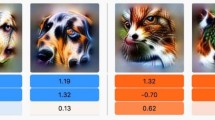Abstract
This chapter provides an introduction and motivates the leading thread of the following ten chapters that were collected to present some of the most recent advances in neural processing models, concerning both the analysis of theoretical properties of novel neural architectures and the illustration of some real–world applications. Not pretending to be exhaustive, this chapter and the whole book delineate an evolving picture of connectionism, in which neural information systems are moving towards approaches that try to exploit the symbolic information available mostly as relations among the data and to specialize themselves, sometimes based on biological inspiration, to cope with difficult applications.
Access this chapter
Tax calculation will be finalised at checkout
Purchases are for personal use only
Preview
Unable to display preview. Download preview PDF.
Similar content being viewed by others
References
de Alencar Barreto, G., Araujo, A., Kremer, S.: A taxonomy for spatiotemporal connectionist networks revisited: The unsupervised case. Neural Computation 15(6), 1255–1320 (2003)
Alessandri, A., Sanguineti, M., Maggiore, M.: Optimization–based learning with bounded error for feedforward neural networks. IEEE Transactions on Neural Networks 13, 261–273 (2002)
Bianchini, M., Gori, M., Sarti, L., Scarselli, F.: Recursive processing of cyclic structures. IEEE Transactions on Neural Networks 17(1), 10–18 (2006)
Bianchini, M., Gori, M., Scarselli, F.: Processing directed acyclic graphs with recursive neural networks. IEEE Transactions on Neural Networks 12(6), 1464–1470 (2001)
Bianchini, M., Maggini, M., Sarti, L., Scarselli, F.: Recursive neural networks for processing graphs with labelled edges: Theory and applications. Neural Networks 18(8), 125–130 (2005)
Bianchini, M., Scarselli, F.: Artificial neural networks for processing graphs with application to image understanding: A survey. In: Jeong, J., Damiani, E. (eds.) Multimedia Techniques for Device and Ambient Intelligence, pp. 179–199. Springer, US (2009)
Biehl, M., Gosh, A., Hammer, B.: Dynamics and generalization ability of LVQ algorithms. Journal of Machine Learning Research 8, 323–360 (2007)
Burger, M., Neubauer, A.: Analysis of Tikhonov regularization for function approximation by neural networks. Neural Networks 16, 79–90 (2002)
Collins, M., Duffy, N.: Convolution kernels for natural language. In: Dietterich, T., Becker, S., Ghahramani, Z. (eds.) Advances in Neural Information Processing Systems. MIT Press, Cambridge (2002)
Farkas, I., Mikkulainen, R.: Modeling the self–organization of directional selectivity in the primary visual cortex. In: Proc. of the International Conference on Artificial Neural Networks, pp. 251–256. Springer, Heidelberg (1999)
Frasconi, P., Gori, M., Kuechler, A., Sperduti, A.: From sequences to data structures: Theory and applications. In: Kolen, J., Kremer, S. (eds.) A Field Guide to Dynamic Recurrent Networks. IEEE Press, Los Alamitos (2001)
Frasconi, P., Gori, M., Sperduti, A.: A general framework for adaptive processing of data structures. IEEE Transactions on Neural Networks 9(5), 768–786 (1998)
Fumera, G., Roli, F.: A theoretical and experimental analysis of linear combiners for multiple classifier systems. IEEE Transactions on Pattern Analysis and Machine Intelligence 27, 942–956 (2005)
Gärtner, T., Flach, P., Wrobel, S.: On graph kernels: Hardness results and efficient alternatives. In: Proc. of the 16th Annual Conference on Computational Learning Theory and the 7th Kernel Workshop, pp. 129–143 (2003)
Hashem, S.: Optimal linear combination of neural networks. Neural Networks 10, 599–614 (1997)
Hinton, G.: Mapping part–whole hierarchies into connectionist networks. Artificial Intelligence 46, 47–75 (1990)
Kohonen, T., Sommervuo, P.: How to make large self–organizing maps fon nonvectorial data. Neural Networks 15(8-9), 945–952 (2002)
Küchler, A., Goller, C.: Inductive learning in symbolic domains using structure–driven recurrent neural networks. In: Görz, G., Hölldobler, S. (eds.) KI 1996. LNCS, vol. 1137, pp. 183–197. Springer, Heidelberg (1996)
Kurkova, V.: Minimization of error functionals over perceptron networks. Neural Computation 20(1), 252–270 (2008)
Plate, T.: Holographic reduced representation. IEEE Transactions on Neural Networks 6, 623–641 (1995)
Pollack, J.: Recursive distributed representations. Artificial Intelligence 46(1-2), 77–106 (1990)
Scarselli, F., Gori, M., Tsoi, A.C., Hagenbuchner, M., Monfardini, G.: The graph neural network model. IEEE Transactions on Neural Networks 20(1), 61–80 (2009)
Sperduti, A.: Labeling RAAM. Connection Science 6(4), 77–106 (1994)
Sperduti, A., Starita, A.: Supervised neural networks for the classification of structures. IEEE Transactions on Neural Networks 8(3), 714–735 (1997)
Trentin, E., Gori, M.: Robust combination of neural networks and hidden Markov models for speech recognition. IEEE Transactions on Neural Networks 14(6), 1519–1531 (2003)
Vishwanathan, S., Smola, A.: Fast kernels for string and tree matching. In: Becker, S., Thrun, S., Obermayer, K. (eds.) Advances in Neural Information Processing Systems, vol. 15, MIT Press, Cambridge (2002)
Author information
Authors and Affiliations
Editor information
Editors and Affiliations
Rights and permissions
Copyright information
© 2009 Springer-Verlag Berlin Heidelberg
About this chapter
Cite this chapter
Bianchini, M., Maggini, M., Scarselli, F., Jain, L.C. (2009). Advances in Neural Information Processing Paradigms. In: Bianchini, M., Maggini, M., Scarselli, F., Jain, L.C. (eds) Innovations in Neural Information Paradigms and Applications. Studies in Computational Intelligence, vol 247. Springer, Berlin, Heidelberg. https://doi.org/10.1007/978-3-642-04003-0_1
Download citation
DOI: https://doi.org/10.1007/978-3-642-04003-0_1
Publisher Name: Springer, Berlin, Heidelberg
Print ISBN: 978-3-642-04002-3
Online ISBN: 978-3-642-04003-0
eBook Packages: EngineeringEngineering (R0)




